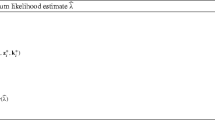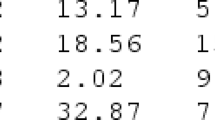Abstract
We develop methodology for conducting inference based on record values and record times derived from a sequence of independent and identically distributed random variables. The advantage of using information about record times as well as record values is stressed. This point is a subtle one, since if the sampling distribution F is continuous then there is no information at all about F in the record times alone; the joint distribution of any number of them does not depend on F. However, the record times and record values jointly contain considerably more information about F than do the record values alone. Indeed, in the case of a distribution with regularly varying tails, the rate of convergence of the exponent of regular variation is two orders of magnitude faster if information about record times is included. Optimal estimators and convergence rates are derived under simple, specific models, and shown to be surprisingly robust against significant departures from those models. However, even under our special models the estimators have irregular properties, including an undefined information matrix. To some extent these difficulties may be alleviated by conditioning and by considering the relationship between maximum likelihood and maximum probability estimators.
Similar content being viewed by others
References
Ballerini, R. and Resnick, S., “Records from improving populations,” J. Appl. Probab. 22, 487–502, (1985).
Ballerini, R. and Resnick, S., “Records in the presence of a linear trend,” Adv. Appl. Probab. 19, 801–828, (1987).
Berred, M., “On record values and the exponent of a distribution with regularly varying upper tail,” J. Appl. Probab. 29, 575–586, (1992).
Becker, R.A., Chambers, J.M., and Wilks, A.R., The New S Language, Wadsworth & Brooks/Cole, Pacific Grove, California, 1988.
Bingham, N.H., Goldie, C., and Teugels, J., Regular Variation. Encyclopedia of Mathematics and its Applications, 27, Cambridge University Press, Cambridge, 1987.
Chatterjee, S. and Chatterjee, S., “New lamps for old: an exploratory analysis of running times in Olympic games,” Appl. Statist. 31, 14–22, (1982).
Csörgő, S., Deheuvels, P., and Mason, D., “Kernel estimates of tail index of a distribution,” Ann. Statist. 13, 1050–1077, (1985).
De Haan, L. and Verkade, E., “On extreme value theory in the presence of a trend,” J. Appl. Probab. 24, 62–76, (1987).
Hall, P., “On some simple estimates of an exponent of regular variation,” J. Roy. Statist. Soc. Ser. B 44, 37–42, (1982).
Hill, B.M., “A simple general approach to inference about the tail of a distribution,” Ann. Statist. 3, 1163–1174, (1975).
Morton, R.H., “Letter to the Editor,” Appl. Statist. 33, 317–318, (1983).
Pickands, J. III, “Statistical inference using extreme order statistics,” Ann. Statist. 3, 119–131, (1975).
Resnick, S.I., “Limit laws for record values,” Stoch. Proc. Appl. 1, 67–82, (1973a).
Resnick, S.I., “Record values and maxima,” Ann. Probab. 1, 650–662, (1973b).
Resnick, S.I., “Extremal processes and record value times,” J. Appl. Probab. 10, 864–868, (1973c).
Resnick, S.I., “Weak convergence to extremal processes,” Ann. Probab. 3, 951–960, (1975).
Resnick, S.I., Extreme Values, Regular Variation, and Point Processes, Springer, New York, 1987.
Shorrock, R.W., “A limit theorem for inter-record times,” J. Appl. Probab. 9, 219–223, (1972).
Shorrock, R.W., “Record values and inter-record times,” J. Appl. Probab. 10, 543–545, (1973).
Shorrock, R.W., “On discrete time extremal processes,” Adv. Appl. Probab. 6, 580–592, (1974).
Shorrock, R.W., “Extremal processes and random measures,” J. Appl. Probab. 12, 316–323, (1975).
Smith, R.L., “Maximum likelihood estimation in a class of nonregular cases,” Biometrika 72, 67–92, (1985).
Smith, R.L. and Miller, J.E., “A non-Gaussian state space model and application to the prediction of records,” J. Roy. Statist. Soc. Ser. B 48, 79–88, (1986).
Smith, R.L., “Forecasting records by maximum likelihood,” J. Amer. Statist. Assoc. 83, 331–338, (1988).
Tryfos, P. and Blackmore, R., “Forecasting records,” J. Amer. Statist. Assoc. 80, 46–50, (1985).
Weiss, L. and Wolfowitz, J., “Maximum probability estimators,” Ann. Inst. Statist. Math. 19, 193–206, (1967).
Weiss, L. and Wolfowitz, J., “Maximum likelihood estimation of a translation parameter of a truncated distribution,” Ann. Statist. 1, 944–947, (1973).
Weiss, L. and Wolfowitz, J., Maximum Probability Estimators and Related Topics, Lecture Notes in Math. 424, Springer, Berlin, 1974.
Author information
Authors and Affiliations
Rights and permissions
About this article
Cite this article
Feuerverger, A., Hall, P. On Statistical Inference Based on Record Values. Extremes 1, 169–190 (1998). https://doi.org/10.1023/A:1009958722622
Issue Date:
DOI: https://doi.org/10.1023/A:1009958722622




